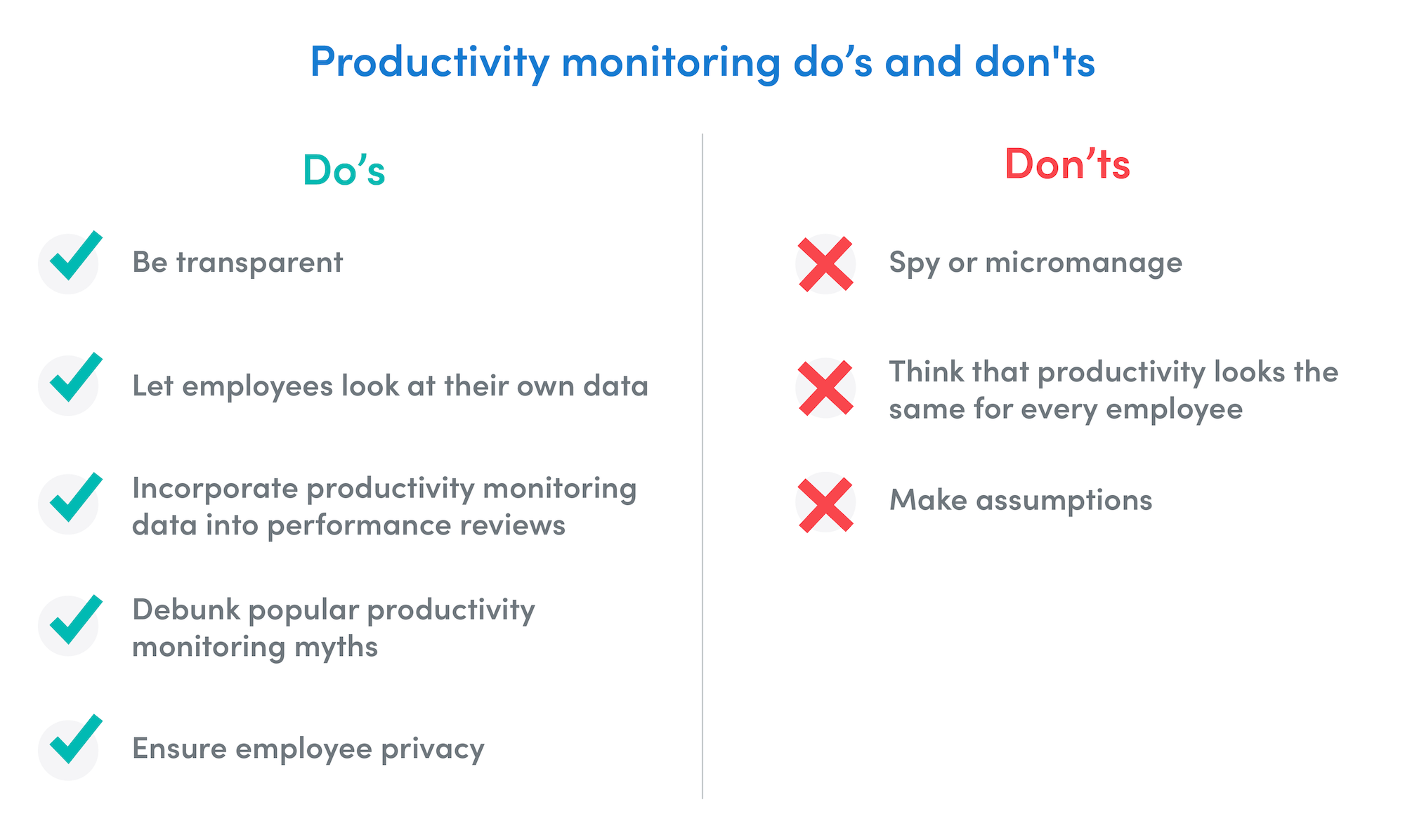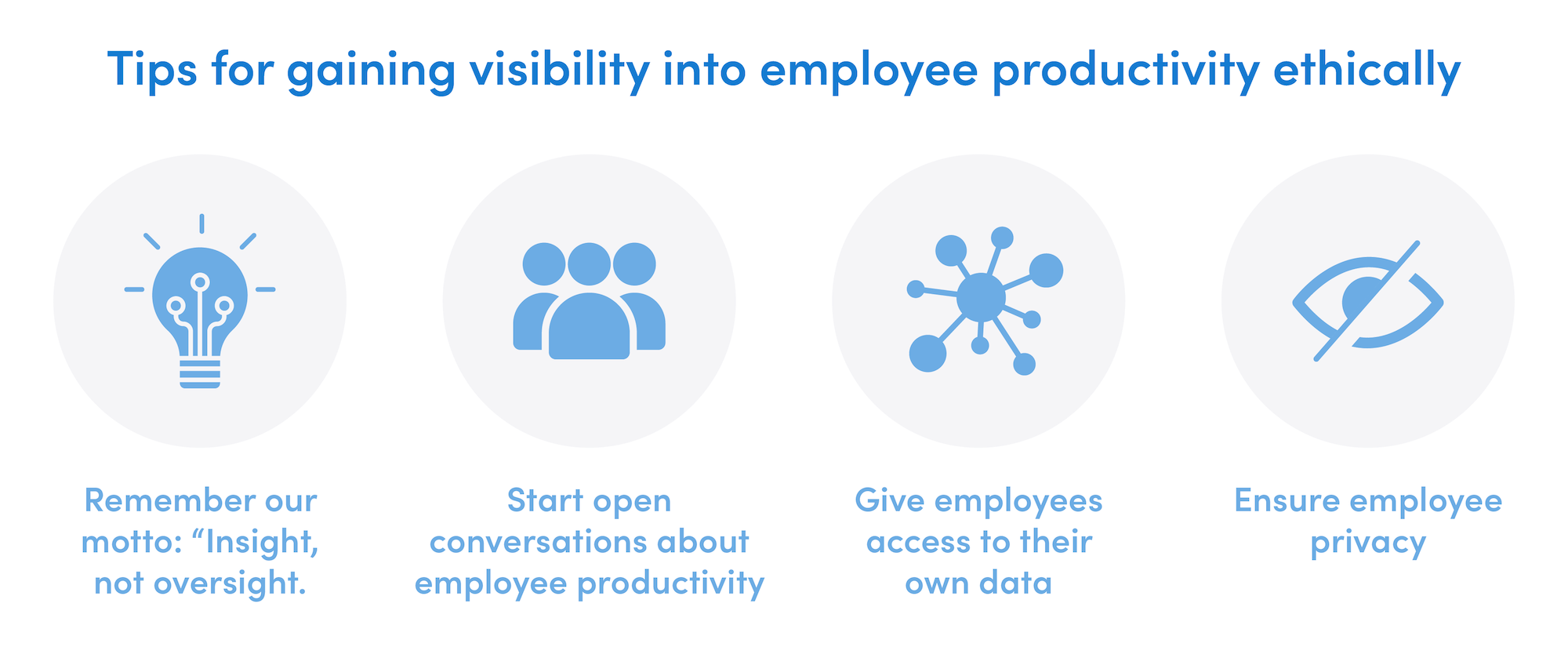Show Hide Topic Menu
- Productivity Management
- How it Works
- Learn how
- Employee Productivity:
A Modern Approach - Productivity Monitoring with Transparency
- 3 Productivity Metrics to Help Your Team Work Wiser
- Productivity Measurement at Your Company
- Tracking Productivity Through Monitoring Software
- Productivity Management for Lasting Change
- Team Productivity Through Workforce Analytics
- What Workforce Productivity Can Teach Leadership
- Productivity vs. Efficiency: Differences and Formulas
- 10 Workplace Productivity Statistics Leaders Should Know
- Employee Productivity:
Learn how to create an environment where employees feel secure and empowered by taking an ethical approach to productivity monitoring.
Productivity monitoring isn’t a new concept, but it has certainly changed as of late. The rise of remote work has made the standard employee activity monitoring many managers take for granted a bit tricky. In an office environment, it’s easy for a manager to ask an employee what they’re working on and see how they’re spending their work hours. Now that employees are working from home across the globe, many managers believe that the only way to get clear visibility into how employees and teams get work done is to spy, either overtly or covertly, on employee activity and productivity levels. As such, it’s no surprise that we’ve seen a recent spike in keylogging and time tracking software in the workplace.
At ActivTrak, we know there’s a better, more ethical way to understand and improve workforce productivity — whether your team is operating out of the office or remotely.
In this chapter, you’ll learn how we’re merging employee productivity monitoring with ethics and transparency at ActivTrak to deliver a solution that empowers team members while also increasing workforce productivity and building trust across teams. We’ll also walk you through the do’s and don’ts of ethical productivity monitoring so you have all the tools you need to start monitoring the right way.
Choose where to start:
- Delivering Productivity Monitoring that Promotes Transparency
- The Do’s and Don’ts of Effective, Transparent Productivity Monitoring
- Increasing Workplace Productivity through Productivity Monitoring
Delivering Productivity Monitoring that Promotes Transparency

When you hear the words “productivity tracking” or “monitoring” you might be a little wary. That’s understandable! According to a 2017 Crowd Research Survey, a whopping 94% of organizations use some sort of employee monitoring software, but they sacrifice employee trust in the process. Only 10% of employees would trust their employer more and not less if they knew their software was being used to track their activity.
No one wants to feel like they’re being watched and judged based on how they spend their work time, whether it’s in the office or working from home. The thing is, there are actually a huge number of benefits to effective, transparent productivity monitoring that keeps employees in the loop with their managers. That’s why it’s so important that the dialogue around productivity monitoring — and the way managers approach that monitoring itself — focuses on it as a collaborative effort that is designed to empower employees, not micromanage them.
Over the years, ActivTrak has done just that, evolving from an employee monitoring tool into a powerful productivity monitoring solution that promotes transparency and trust between employers and employees. We believe that employee productivity monitoring isn’t about surveilling team members, tracking time, or springing impromptu check-ins on your employees during their idle time. Instead, it’s about using digital user activity in context to find out how work gets done, how teams interact, how employees can improve, and how results can be optimized.
You’ll notice the language we use here — it includes a lot of “how’s.” With empowerment-based productivity monitoring, there are no more accusatory questions like “What are you doing on company time?” or “Why hasn’t more work been done?” Instead, our motto is “Insight, not oversight.” We want to give managers the tools and contextual data they need to help their employees make the most of their workday, not give them new ways to spy. This shift in perspective is key to creating an effective and ethical way to monitor employee productivity. This shift is also key to boosting employee buy-in and fostering a more open, data-driven workforce overall. According to an Accenture survey, 92% of employees are open to the idea of collecting data on their work activity as long as it’s used to boost their own well-being and performance. Here’s how to bring employee productivity monitoring software into your enterprise without spooking your team or compromising ethics.
The Do’s and Don'ts of Effective, Transparent Productivity Monitoring
We know that conceptualizing the difference between productivity tracking and employee monitoring can be challenging if you’ve never thought about it before. With employee tracking software, you’re focused on gathering user activity on everything that is and isn’t work-related to determine if your employees are productive. There’s no context here — just cold, hard “facts” that either do or don’t live up to your expectations of employee performance. With productivity monitoring, you’re only gathering enough user activity to gain insight into how your employees are working so you can in turn help them work smarter, better, and more efficiently. Productivity monitoring comes from a place of openness and empowerment, not control.
Here’s how to do productivity monitoring the right way:
Do:
- Be transparent: Your employees want to feel valued and trusted, which is why it’s so important that you be upfront with them about your productivity monitoring activities. That includes telling them what data you’re collecting and how you intend to use it so they understand how you will leverage your productivity analytics to support both personal and organizational growth.
- Let employees look at their own data: This can have a huge impact when it comes to boosting employee trust and eliminating any notion of spying. Giving your team access to their own real-time productivity data proves to them that you’re not using these detailed reports to hold something over them. Also, it empowers employees to take the initiative to manage themselves and make improvements to their own overall productivity without needing outside intervention.
- Incorporate productivity monitoring data into performance reviews: Effective monitoring is about more than just increasing employee productivity. While your collected data can (and should) be used to facilitate conversations about key areas of improvement as well as time management, work-life balance, and successful remote work habits, it can also drive well-deserved recognition. Let your team members see the real-time data on what they’re doing well! Performance reviews are a great time to use the results of your monitoring to boost employee engagement and create a stronger, more satisfied workforce.
- Debunk popular productivity monitoring myths: There are a lot of myths surrounding productivity monitoring covering everything from the idea that it is only for remote workers to the fact that it violates employee privacy. To get your employees on board, it’s important that you debunk these myths both verbally and in practice.
- Ensure employee privacy: One of the biggest concerns employees have with productivity tracking is that it violates their privacy. These fears aren’t unfounded given that traditional employee monitoring solutions record every action a person performs through mouse clicks and keylogging, and capture employee passwords and personal data.
Unlike these solutions, ActivTrak is dedicated to protecting employee privacy. All data in the ActivTrak platform is encrypted in transit and at rest using AES-128 and 256 encryption, the strongest types available. Single sign-on (SSO) and multi-factor authentication ensure that productivity data is only accessed by authorized users. Plus, you own all of the data in your account and we don’t view any of your private information. By using a trustworthy productivity monitoring solution, you can assure your employees that their data is being protected and used responsibly while still collecting the data you want.
Don’t:
- Spy or micromanage! Employee monitoring software is designed to deliver insights to help improve your business. It should never be used to encourage spying or harassing behaviors.
- Think that productivity looks the same for every employee: Productivity can look very different depending on a person’s position within your company and how they choose to manage their time. Focus on finding baselines and analyzing productivity metrics for similar roles instead of comparing apples and oranges.
- Make assumptions: If you’re worried about any data you’re seeing, you should always talk to your employee first to clear up any misunderstandings. Jumping to conclusions erodes trust and makes it harder to take accurate and effective corrective actions.
Increasing Workplace Productivity through Productivity Monitoring
Monitoring can be hugely beneficial for both employers and employees when it comes to increasing workforce productivity, but only if it’s done with a focus on ethics and transparency.
The good news is, it’s possible to gain clear visibility into employee productivity without tracking, surveilling, or alienating your employees. All you need are the right tools and the right perspective!
Here are a few pro tips to help you do that:
- Remember our motto: “Insight, not oversight.” Let it guide everything you do.
- Practice empathy and transparency by starting open conversations about employee productivity.
- Give employees access to their own data — productivity management is a team effort!
- Ensure employee privacy! Only use employee productivity monitoring software guaranteed to keep your team safe.
Once you have a clear understanding of what employee productivity can and should look like in your enterprise, you can start taking active steps to improve it. That starts with productivity measurement, which is the subject of this playbook’s third chapter. Stay tuned!


